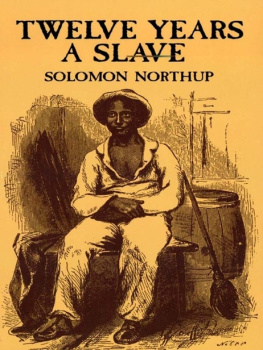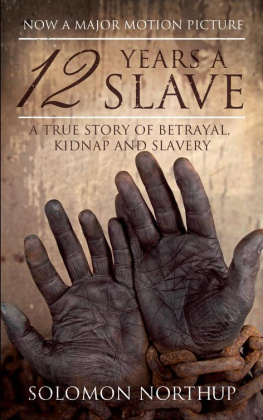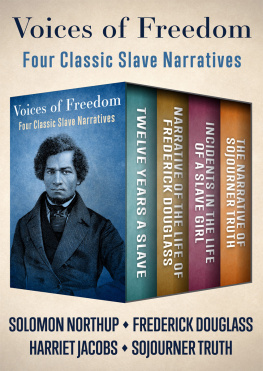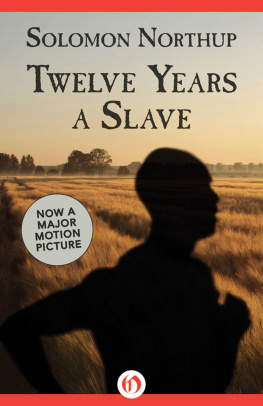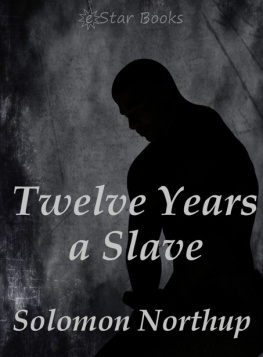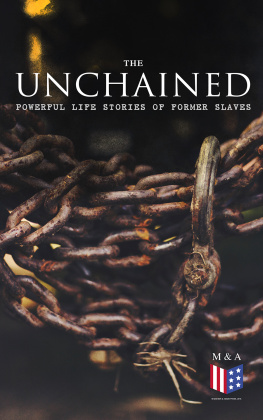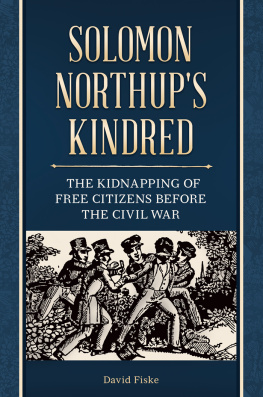Solomon Northup - Twelve Years a Slave
Here you can read online Solomon Northup - Twelve Years a Slave full text of the book (entire story) in english for free. Download pdf and epub, get meaning, cover and reviews about this ebook. City: Louisiana., United States, year: 2016, publisher: Create Space;Dover Publications, genre: Non-fiction. Description of the work, (preface) as well as reviews are available. Best literature library LitArk.com created for fans of good reading and offers a wide selection of genres:
Romance novel
Science fiction
Adventure
Detective
Science
History
Home and family
Prose
Art
Politics
Computer
Non-fiction
Religion
Business
Children
Humor
Choose a favorite category and find really read worthwhile books. Enjoy immersion in the world of imagination, feel the emotions of the characters or learn something new for yourself, make an fascinating discovery.
- Book:Twelve Years a Slave
- Author:
- Publisher:Create Space;Dover Publications
- Genre:
- Year:2016
- City:Louisiana., United States
- Rating:4 / 5
- Favourites:Add to favourites
- Your mark:
- 80
- 1
- 2
- 3
- 4
- 5
Twelve Years a Slave: summary, description and annotation
We offer to read an annotation, description, summary or preface (depends on what the author of the book "Twelve Years a Slave" wrote himself). If you haven't found the necessary information about the book — write in the comments, we will try to find it.
Kidnapped into slavery in 1841, Northup spent 12 years in captivity. This autobiographical memoir represents an exceptionally detailed and accurate description of slave life and plantation society. A moving, vital testament to one of slaverys many thousand gone who retained his humanity in the bowels of degradation. Saturday Review. 7 illustrations. Index.
Twelve Years a Slave — read online for free the complete book (whole text) full work
Below is the text of the book, divided by pages. System saving the place of the last page read, allows you to conveniently read the book "Twelve Years a Slave" online for free, without having to search again every time where you left off. Put a bookmark, and you can go to the page where you finished reading at any time.
Font size:
Interval:
Bookmark:

Copyright Copyright 1970 by Dover Publications, Inc. All rights reserved.
Bibliographical Note
This Dover edition, first published in 2000, is the second Dover unabridged republication of the work first published in 1853 by Derby and Miller, Auburn, New York. The Introduction written by Philip S. Foner for the 1970 Dover edition is included in this edition, as are 7 illustrations from the 1854 edition.
Library of Congress Cataloging-in-Publication Data
Northup, Solomon, b. 1808.
Twelve years a slave / Solomon Northup ; introduction by Philip S. Foner. p. cm. Originally published: Auburn, N.Y. : Derby and Miller. Includes index.
9780486130699
1. Northup, Solomon, b. 1808. 2. Slaves-United StatesBiography. 3. Afro-Americans-Biography. 4. Plantation lifeLouisiana-History-19th century. 5. Slavery-LouisianaHistory-19th century. I. Title.
E444 N87 2000
306.362092-dc21
99-089488
Manufactured in the United States by Courier Corporation 41143508 www.doverpublications.com
INTRODUCTION TO THE DOVER EDITION
COMMENTING on the literally hundreds of slave narratives published during the antislavery crusade, Ephraim Peabody, a contemporary writer, noted that they were calculated to exert a very wide influence on public opinion because they contained the victims account of the workings of this great institution. Among the autobiographies by former slaves, a few were especially effective in presenting a clear picture of the nature and operations of that peculiar institution. The most famous were Frederick Douglass Narrative, published in 1845, William W. Browns Narrative, published two years later, Josiah Hensons autobiography, published in 1849, and Solomon Northups Narrative, published in 1853. Northups account is considered one of the most authentic descriptions of slavery from the viewpoint of the slave himself. Ulrich B. Phillips, who doubted the value and authenticity of many of the slave autobiographies, wrote of Northups book: ... this one has a tone which engages confidence. Its pictures of plantation life and labor are of particular interest.
Kidnapping of free Negroes and their sale into slavery was not uncommon, especially as the price of slaves mounted in the decades following the legal closing of the African slave trade. But one of the most notorious kidnapping cases was that of Solomon Northup. He had been a raftsman and farmer around Lake Champlain in New York until 1841 when, on the ground of his talent with the fiddle, two strangers offered him employment in a circus which they said was then at Washington. Going there with them, without even bidding farewell to his wife and children, for what he thought would be merely temporary employment at good wages, Northup was drugged, shackled, robbed of his free papers, and sold to the firm of Price, Burch and Co., a well-known slave trading establishment. Each time he protested that he was a free man, Northup was whipped until he learned not to mention the fact to anyone. Confined in a slave jail within the very shadow of the capitol, Northup observed: The voices of patriotic representatives boasting of freedom and equality, and the rattling of the poor slaves chains almost commingled. These slave pens were constructed by large traders, and the Negroes were confined in them while awaiting sale or transportation to a market. Northup was shipped to the New Orleans market. As he was marched to the ship handcuffed in a slave coffee, he reflected that the slaves were moving through the capital of a nation, whose theory of government, we are told, rests on the foundation of mans inalienable right to life, LIBERTY, and the pursuit of happiness! Hail! Columbia, happy land, indeed !
At New Orleans, Northup was sold by the firm of Theophilus Freeman to a planter who lived on a Texas road, twelve miles from Lamourie. Sold again to a planter near the Red River in Louisiana, he was enslaved on a plantation for a dozen years until a letter, which a friendly white carpenter had written for him, brought one of his former patrons with an agents commission from the Governor of New York. With the assistance of the local authorities, Northups real identity was established, his liberty procured, and in 1853 he returned to his wife and children at Saratoga.
In closing his Narrative, Northup comments: I doubt not hundreds have been as unfortunate as myself; that hundreds of free citizens have been kidnapped and sold into slavery, and are at this moment wearing out their lives on plantations in Texas and Louisiana.
In the year of his rescue, David Wilson took down Northups story as a correct picture of slavery. It was published that year with the title, Twelve Years a Slave: Narrative of Solomon Northup. The title page announced the author as a citizen of New York, kidnapped in Washington City in 1841, and rescued in 1853, from a cotton plantation near the Red River in Louisiana,. An Appendix contained the text of the law passed by the New York legislature in 1840 to protect the free citizens of the state from being kidnapped or reduced to slavery, the petition of Mrs. Anne Northup, Northups wife, to the Governor of New York, which led to her husbands restitution to freedom, and letters establishing the authenticity of Northups claim that he was a free Negro who had been kidnapped and sold into slavery.
Northups Narrative was dedicated to Harriet Beecher Stowe whose A Key to Uncle Toms Cabin, published in 1853 as a reply to the attacks on the accuracy of the facts in Uncle Toms Cabin, had noted that Northup was carried to a plantation in the Red River countrythat same region where the scene of Uncle Toms captivity was laidand his account of this plantation, and the mode of life there, and some incidents which he described, form a striking parallel to that history. In his dedication, Northup cited his Narrative as affording another key to Uncle Toms Cabin.
Within a year after its publication, Northups Narrative had sold 25,000 copies. It is the 1854 edition, carrying the notice Twentieth Thousand, which is reprinted in this volume. The author made no changes from the first edition other than reprinting on the dedication page the reference to him in A Key to Uncle Toms Cabin.
Written immediately after Northups rescue from slavery, the Narrative had none of the errors in detail present in accounts put down from distant memory. It is not surprising, then, that Northups slave narrative has proved to be an important source for scholars studying the internal slave trade, slave auctions and the separation of slave families, the life of the slave on the Southern plantations, the role of the slave driver, and the extent of slave resistance. (Like Frederick Douglass, Solomon Northup whipped his overseer and was involved in two near-rebellions.) Northups picture of cotton plantation work is one of the few detailed contemporary portraits that existthat is, from the viewpoint of the slave. His description of conditions on a cotton plantation in the mid-1840s and early 1850s is certainly one of the most valuable we have. His account of how the woods and swamps of Louisiana were continually filled with runaways who stole provisions from the surrounding farms is extremely useful in the study of the relatively permanent settlements of runaway slaves (called maroons) which were to be found in woods and swamps in many parts of the South.
Ten years, Northup wrote, I was compelled to address him [the master] with downcast eyes and uncovered headin the attitude and language of the slave,. The whip was the antidote to any infringement of this conduct. Indeed, as Northups narrative makes abundantly clear, the whip was the symbol of slavery, especially in the deep South. Northups description of his brutal Louisiana master whose chief delight was in dancing with his niggers or lashing them about the yard with his long whip, and of the repeated floggings of the slave girl, Patsey, made a tremendous impact on thousands of readers. Few of these readers could disagree with Northups insight about slavery as he expressed it toward the end of his narrative:
Next pageFont size:
Interval:
Bookmark:
Similar books «Twelve Years a Slave»
Look at similar books to Twelve Years a Slave. We have selected literature similar in name and meaning in the hope of providing readers with more options to find new, interesting, not yet read works.
Discussion, reviews of the book Twelve Years a Slave and just readers' own opinions. Leave your comments, write what you think about the work, its meaning or the main characters. Specify what exactly you liked and what you didn't like, and why you think so.

